Air Temperature Variations Due to Different Roofs and Their Impact on Energy Consumption and Emissions: Mexicali University Campus Case Study
Abstract
1. Introduction
2. Materials and Methods
3. Results
3.1. Temperature and Model
3.2. Temperature and Efficiency
3.3. Electricity Consumption and GHG Emissions
4. Discussion
5. Conclusions
Author Contributions
Funding
Institutional Review Board Statement
Informed Consent Statement
Data Availability Statement
Acknowledgments
Conflicts of Interest
References
- Nejat, P.; Jomehzadeh, F.; Taheri, M.M.; Gohari, M.; Abd Majid, M.Z. A global review of energy consumption, CO2 emissions and policy in the residential sector (with an overview of the top ten CO2 emitting countries). Renew. Sustain. Energy Rev. 2015, 43, 843–862. [Google Scholar] [CrossRef]
- The European Parliament and the Council of the Europe. Directive (EU) 2018/844 of the European Parliament and of the Council of May 30 2018 amending Directive 2010/31/EU on the energy performance of buildings and Directive 2012/27/EU on energy efficiency. Off. J. Eur. Union 2018, 156, 77. Available online: https://eur-lex.europa.eu/legal-content/EN/TXT/PDF/?uri=CELEX:32018L0844&from=IT (accessed on 1 February 2022).
- Patiño-Cambeiro, F.; Armesto, J.; Bastos, G.; Prieto-López, J.I.; Patiño-Barbeito, F. Economic appraisal of energy efficiency renovations in tertiary buildings. Sustain. Cities Soc. 2019, 47, 101503. [Google Scholar] [CrossRef]
- Valdiserri, P.; Biserni, C. Energy performance of an existing office building in the northern part of Italy: Retrofitting actions and economic assessment. Sustain. Cities Soc. 2016, 27, 65–72. [Google Scholar] [CrossRef]
- United States Energy Information Administration. Energy Consumption Estimates by Sector. Available online: http://www.eia.gov/consumption/ (accessed on 10 January 2022).
- D&R International, Ltd. 2011 Buildings Energy Data Book; United States Department of Energy: Washington, DC, USA, 2012. Available online: https://ieer.org/resource/energy-issues/2011-buildings-energy-data-book/ (accessed on 7 February 2022).
- Konopacki, S.; Akbari, H.; Gartland, L. Cooling Energy Savings Potential of Light-Colored Roofs for Residential and Commercial Buildings in 11 US Metropolitan Areas; Lawrence Berkeley National Laboratory: Berkeley, CA, USA, 1997. [CrossRef]
- Akbari, H.A.; Konopacki, S.J. The impact of reflectivity and emissivity of roofs on building cooling and heating energy use. In Proceedings of the Thermal Performance of the Exterior Envelopes of Buildings VII, Clear-water Beach, FL, USA, 6–10 December 1998; Available online: https://web.ornl.gov/sci/buildings/conf-archive/1998%20B7%20papers/003_Akbari.pdf (accessed on 2 December 2021).
- Konopacki, S.; Gartland, L.; Akbari, H.; Rainer, L. Demonstration of Energy Savings of Cool Roofs, Lawrence Berkeley National Laboratory Report LBNL-40673, Berkeley, CA, USA. 1998. Available online: https://eta-publications.lbl.gov/sites/default/files/lbnl-40673.pdf (accessed on 2 December 2021).
- Konopacki, S.; Akbari, H. Measured Energy Savings and Demand Reduction from a Reflective Roof Membrane on a Large Retail Store in Austin, Lawrence Berkeley National Laboratory Report, LBNL-47149. 2001. Available online: https://www.osti.gov/servlets/purl/787107 (accessed on 2 December 2021).
- Akbari, H.; Levinson, R.M.; Rainer, L. Monitoring the energy use effects of cool roofs on California commercial buildings. Energy Build. 2005, 37, 1007–1016. [Google Scholar] [CrossRef]
- Akbari, H.; Konopacki, S. Calculating energy saving potentials of heat island reduction strategies. Energy Policy 2005, 33, 721–756. [Google Scholar] [CrossRef]
- Levinson, R.; Akbari, H. Potential benefits of cool roofs on commercial buildings: Conserving energy, saving money, and reducing emission of greenhouse gases and air pollutants. Energy Effic. 2010, 3, 53–109. [Google Scholar] [CrossRef]
- Jandaghian, Z.; Akbari, H. The Effect of Increasing Surface Albedo on Urban Climate and Air Quality: A Detailed Study for Sacramento, Houston, and Chicago. Climate 2018, 6, 19. [Google Scholar] [CrossRef]
- Saffari, M.; Piselli, C.; De Gracia, A.; Pisello, A.L.; Cotana, F.; Cabeza, L.F. Thermal stress reduction in cool roof membranes using phase change materials (PCM). Energy Build. 2018, 158, 1097–1105. [Google Scholar] [CrossRef]
- Silva, H., III; Fillpot, B.S. Modeling nexus of urban heat island mitigation strategies with electricity/power usage and consumer costs: A case study for Phoenix, Arizona, USA. Theor. Appl. Climatol. 2018, 131, 661–669. [Google Scholar] [CrossRef]
- ASHRAE & ANSI/ASHRAE. Advanced Energy Design Guide for Small to Medium Office Buildings; American Society of Heating, Refrigerating, and Air-Conditioning Engineers, Inc.: Atlanta, GA, USA, 2011; Available online: https://thermalbridgingsolutions.com/wp-content/uploads/2019/12/AEDG_50percent-energy-reduction_Small-to-Medium-Commercial-Buildings.pdf (accessed on 12 January 2022).
- Berdahl, P.; Bretz, S. Preliminary survey of the solar reflectance of cool roofing materials. Energy Build. 1997, 25, 149–158. [Google Scholar] [CrossRef]
- Wray, C.; Akbari, H. The effects of roof reflectance on air temperatures surrounding a rooftop condensing unit. Energy Build. 2008, 40, 11–28. [Google Scholar] [CrossRef]
- Testa, J.; Krarti, M. Evaluation of energy savings potential of variable reflective roofing systems for US buildings. Sustain. Cities Soc. 2017, 31, 62–73. [Google Scholar] [CrossRef]
- Oropeza-Perez, I.; Østergaard, P. Energy saving potential of utilizing natural ventilation under warm conditions—A case study of Mexico. Appl. Energy 2014, 130, 20–32. [Google Scholar] [CrossRef]
- Rosas-Flores, J.A.; Rosas-Floresa, D.; Morillόn-Gálvezb, D. Saturation, energy consumption, CO2 emission and energy efficiency from urban and rural households appliances in Mexico. Energy Build. 2011, 43, 10–18. [Google Scholar] [CrossRef]
- Tong, Z.; Chen, Y.; Malkawi, A.; Liu, Z.; Freeman, R.B. Energy saving potential of natural ventilation in China: The impact of ambient air pollution. Appl. Energy 2016, 179, 660–668. [Google Scholar] [CrossRef]
- Boot, L.M.; Wang, Y.H.; Chiang, C.M.; Lai, C.M. Effects of a Green Space Layout on the Outdoor Thermal Environment at the Neighborhood Level. Energies 2012, 5, 3723–3735. [Google Scholar] [CrossRef]
- Lai, M.M.; Wang, Y.H. Energy-Saving Potential of Building Envelope Designs in Residential Houses in Taiwan. Energies 2011, 4, 2061–2076. [Google Scholar] [CrossRef]
- TKE Blog 2019. Taking Care of Urban Microclimates through Better Design and Greater Energy Efficiency. Available online: https://www.urban-hub.com/energy_efficiency/rethinking-the-use-of-urban-microclimates/ (accessed on 27 April 2023).
- Javanroodi, K.; Nik, V.M. Impacts of Microclimate Conditions on the Energy Performance of Buildings in Urban Areas. Buildings 2019, 9, 189. [Google Scholar] [CrossRef]
- Taha, H. Urban climates and heat islands: Albedo, evapotranspiration, and anthropogenic heat. Energy Build. 1997, 25, 99–103. [Google Scholar] [CrossRef]
- Yang, S.; Wang, L.; Stathopoulos, T.; Marey, A.M. Urban microclimate and its impact on built environment—A review. Build. Environ. 2023, 238, 110334. [Google Scholar] [CrossRef]
- Akbari, H.; Pomerantz, M.; Taha, H. Cool surfaces and shade trees to reduce energy use and improve air quality in urban areas. Sol. Energy 2001, 70, 295–310. [Google Scholar] [CrossRef]
- Li, X.; Zhou, Y.; Yu, S.; Jia, G.; Li, H.; Li, W. Urban heat island impacts on building energy consumption: A review of approaches and findings. Energy 2019, 174, 407–419. [Google Scholar] [CrossRef]
- Alshahrani, J.; Boait, P. Reducing high energy demand associated with air-conditioning needs in Saudi Arabia. Energies 2019, 12, 87. [Google Scholar] [CrossRef]
- Shahmohamadi, P.; Che-Ani, A.I.; Maulud, K.N.A.; Tawil, N.M.; Abdullah, N.A.G. The Impact of Anthropogenic Heat on Formation of Urban Heat Island and Energy Consumption Balance. Urban Stud. Res. 2011, 2011, 1–9. [Google Scholar] [CrossRef]
- Santillán-Soto, N.; García-Cueto, O.R.; Lambert-Arista, A.A.; Ojeda-Benítez, S.; Cruz-Sotelo, S. Comparative Analysis of Two Urban Microclimates: Energy Consumption and Greenhouse Gas Emissions. Sustainability 2019, 11, 2045. [Google Scholar] [CrossRef]
- García-Cueto, O.R.; Santillán-Soto, N. Modeling Extreme Climate Events: Two Case Studies in México; Intechopen: London, UK, 2012; Available online: https://www.intechopen.com/books/climate-models/modeling-extreme-climate-events-two-case-studies-in-mexico (accessed on 10 December 2021). [CrossRef]
- Goodman Air Conditioning & Heating. Available online: http://www.goodmanmfg.com/Portals/0/pdf/SS/SS-GPC14H.pdf (accessed on 28 January 2021).
- Environmental Protection Agency EPA. Greenhouse Gas Equivalencies Calculator. 2019. Available online: https://www.epa.gov/energy/greenhouse-gas-equivalencies-calculator (accessed on 16 March 2023).
- EPA AVERT, U.S. Greenhouse Gas Equivalencies Calculator-Calculations and References 2019. Available online: https://www.epa.gov/energy/greenhouse-gases-equivalencies-calculator-calculations-and-references (accessed on 2 December 2021).
- Lee, S.; Moon, H.; Choi, Y.; Yoon, D.K. Analyzing thermal characteristics of urban streets using a thermal imaging camera: A case study on commercial streets in Seoul, Korea. Sustainability 2018, 10, 519. [Google Scholar] [CrossRef]
- Doulos, L.; Santamouris, M.; Livada, I. Pasive cooling of outdoor urban spaces. The role of materials. Sol. Energy 2004, 77, 231–249. [Google Scholar] [CrossRef]
- WMO. World Meteorological Organization. Guide to Instruments and Methods of Observation. Volume I—Measurement of Meteorological Variables. 2021. Available online: https://library.wmo.int/index.php?id=12407&lvl=notice_display (accessed on 27 April 2023).
- Deng, C.; Zhang, X.; Huang, Y.; Bao, Y. Equipping Seasonal Exponential Smoothing Models with Particle Swarm Optimization Algorithm for Electricity Consumption Forecasting. Energies 2021, 14, 4036. [Google Scholar] [CrossRef]
- Obringer, R.; Nateghi, R.; Maia-Silva, D.; Mukherjee, S.; Cr, V.; McRoberts, D.B.; Kumar, R. Implications of increasing household air conditioning use across the United States under a warming climate. Earth’s Future 2022, 10, e2021EF002434. [Google Scholar] [CrossRef]
- Pérez-Tello, C.; Campbell-Ramírez, H.; Suástegui-Macías, J.A.; Reinhardt, M.S. Methodology of Energy Management in Housing and Buildings of Regions with Hot and Dry Climates, HVAC System; IntechOpen: London, UK, 2018; Available online: https://www.intechopen.com/chapters/61924 (accessed on 28 January 2021). [CrossRef]
- Rawat, M.; Singh, R.N. A study on the comparative review of cool roof thermal performance in various regions. Energy Built Environ. 2022, 3, 327–347. [Google Scholar] [CrossRef]
- Hernández-Pérez, I.; Xamán, J.; Macías-Melo, E.V.; Aguilar-Castro, K.M.; Zavala-Guillén, I.; Hernández-López, I.; Simá, E. Experimental thermal evaluation of building roofs with conventional and reflective coatings. Energy Build. 2018, 158, 569–579. [Google Scholar] [CrossRef]
- Santillán-Soto, N.; García-Cueto, R.; Haro-Rincón, Z.; Ojeda-Benítez, S.; Quintero-Núñez, M.; Velázquez-Limón, N. Radiation Balance of Urban Materials and Their Thermal Impact in Semi-Desert Region: Mexicali, México Study Case. Atmosphere 2015, 6, 1578–1589. [Google Scholar] [CrossRef]
- Natanian, J.; Maiullari, D.; Yezioro, A.; Auer, T. Synergetic urban microclimate and energy simulation parametric workflow. J. Phys. Conf. Ser. 2019, 1343, 012006. [Google Scholar] [CrossRef]
- Hong, T.; Xu, Y.; Sun, K.; Zhang, W.; Luo, X.; Hooper, B. Urban microclimate and its impact on building performance: A case study of San Francisco. Urban Clim. 2021, 38, 100871. [Google Scholar] [CrossRef]
- Xu, L.; Tong, S.; He, W.; Zhu, W.; Mei, S.; Cao, K.; Yuan, C. Better understanding on impact of microclimate information on building energy modelling performance for urban resilience. Sustain. Cities Soc. 2022, 80, 103775. [Google Scholar] [CrossRef]
- Karpio, K.; Łukasiewicz, P.; Nafkha, R. New Method of Modeling Daily Energy Consumption. Energies 2023, 16, 2095. [Google Scholar] [CrossRef]
- Suástegui-Macías, J.A.; Pérez Tello, C.; Acuña Ramírez, A.; Lambert Arista, A.A.; Magaña Almaguer, H.D.; Rosales Escobedo, P.F.; Ruelas Puente, A.H. Assessment of electrical saving from energy efficiency programs in the residential sector in Mexicali, Mexico. Sustain. Cities Soc. 2018, 38, 795–805. [Google Scholar] [CrossRef]
- Jim, C.Y. Air-conditioning energy consumption due to green roofs with different building thermal insulation. Appl. Energy 2014, 128, 49–59. [Google Scholar] [CrossRef]
- García-Cueto, O.R.; López-Velázquez, E.; Santillán-Soto, N.; Casilla-Higuera, A.; Bojórquez-Moráles, G.; Flores-Jiménez, D. Aplicación del Modelo Estadístico de Reducción de Escala a Algunas Ciudades de México. Book: El Clima, Aire, Agua, Tierra y Fuego. 2018. Available online: https://www.researchgate.net/publication/319434922_Extremos_climaticos_en_ciudades_de_Mexico_Climate_extremes_in_mexican_cities (accessed on 27 April 2022).
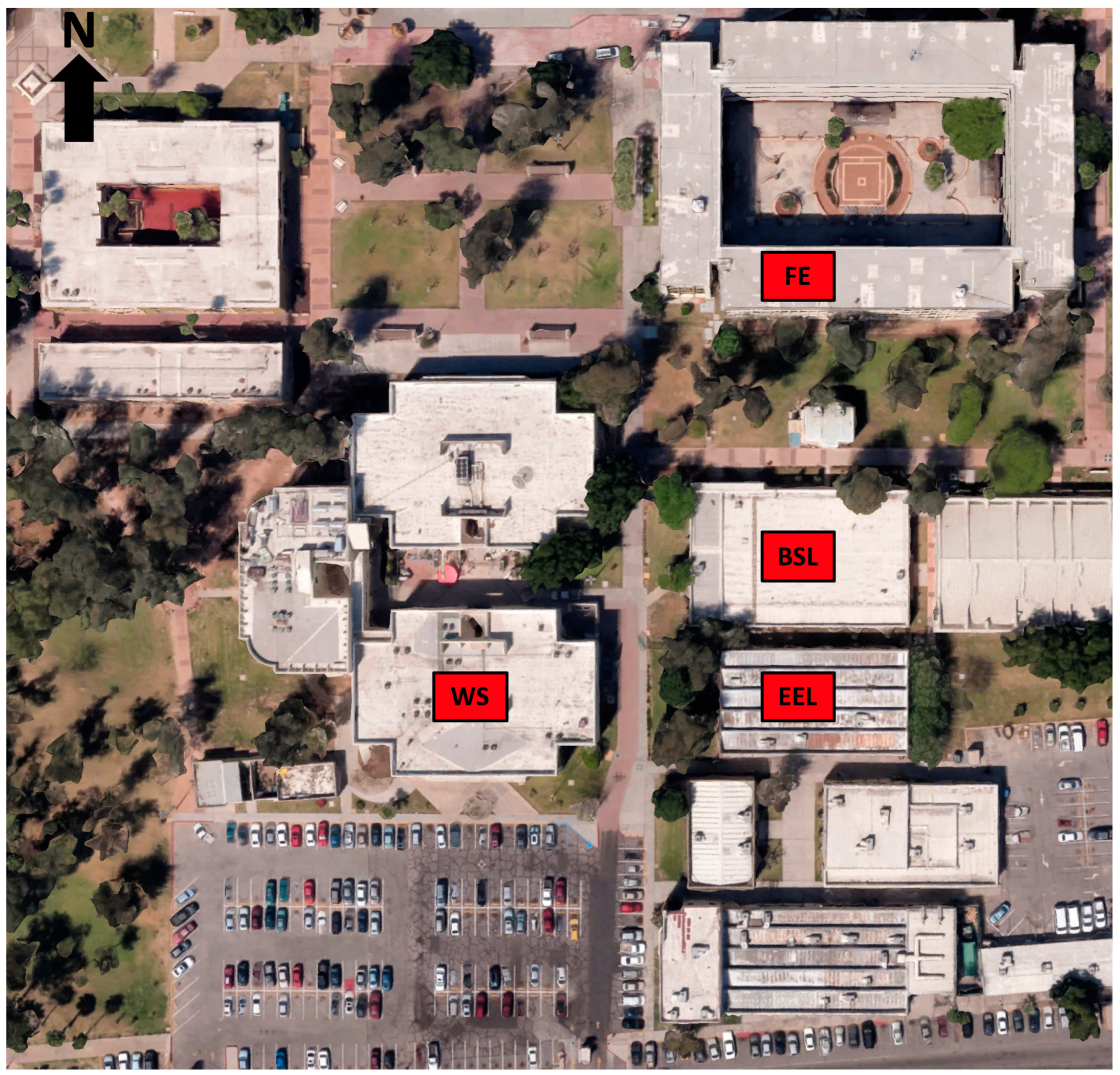
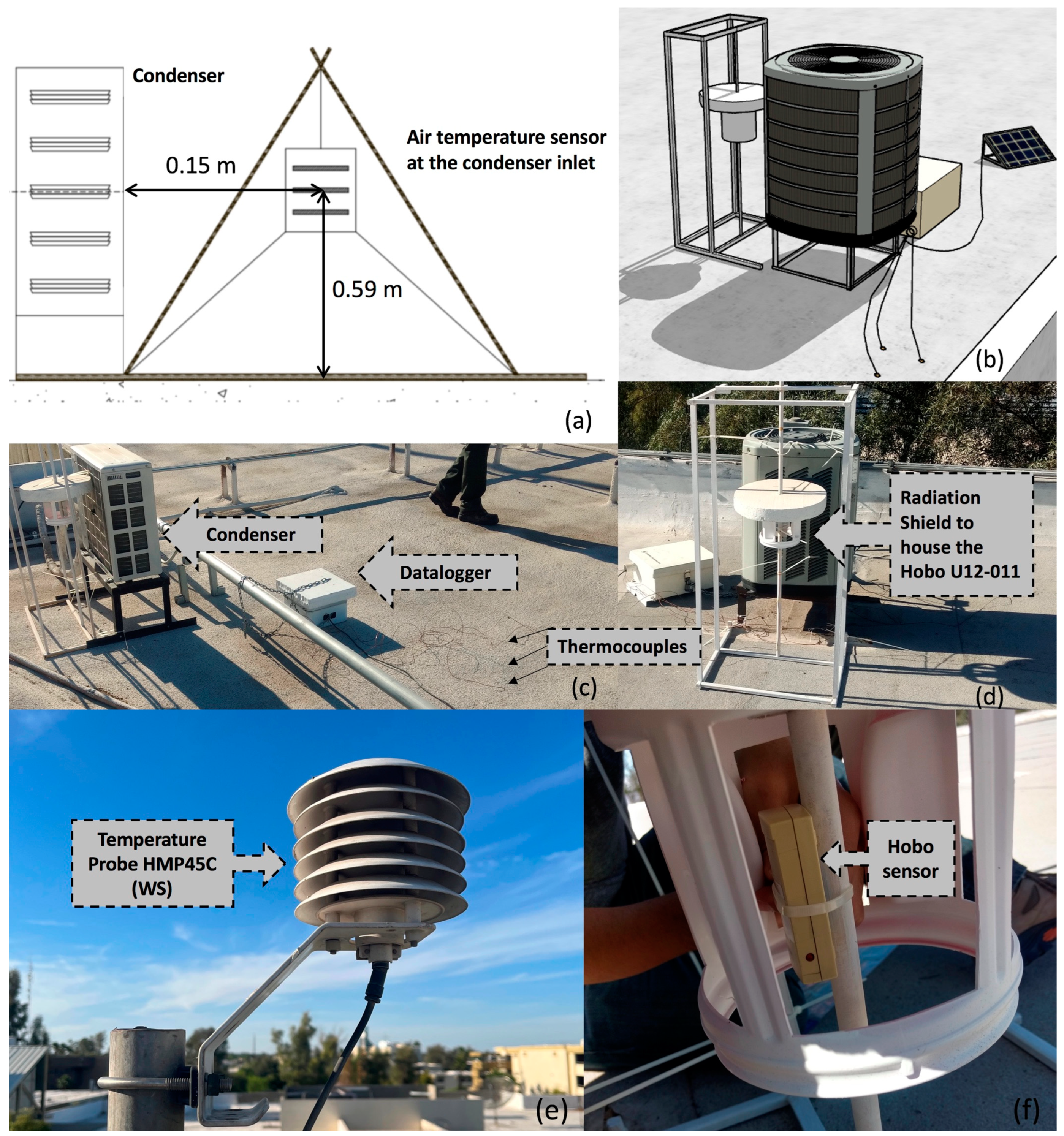

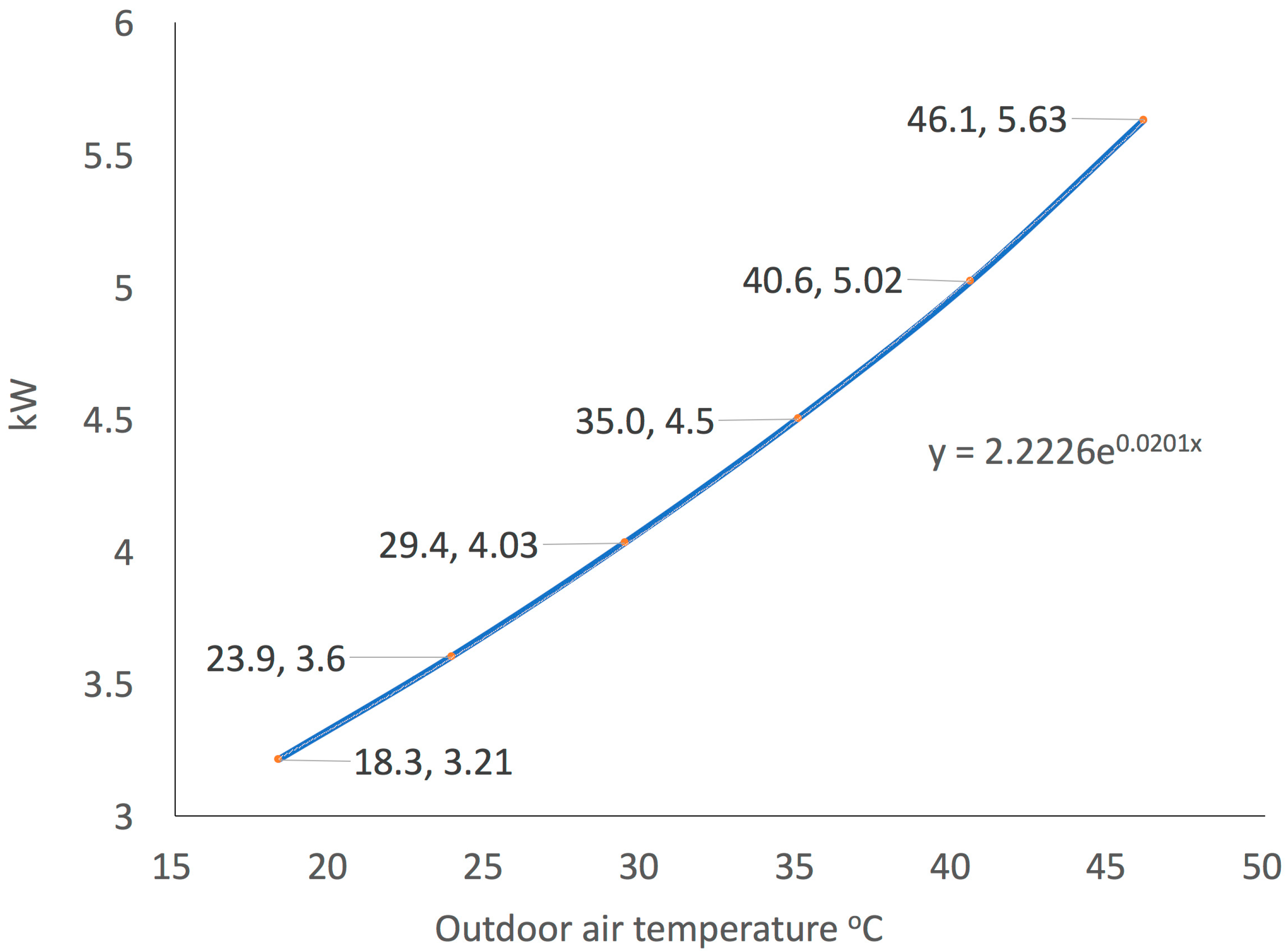
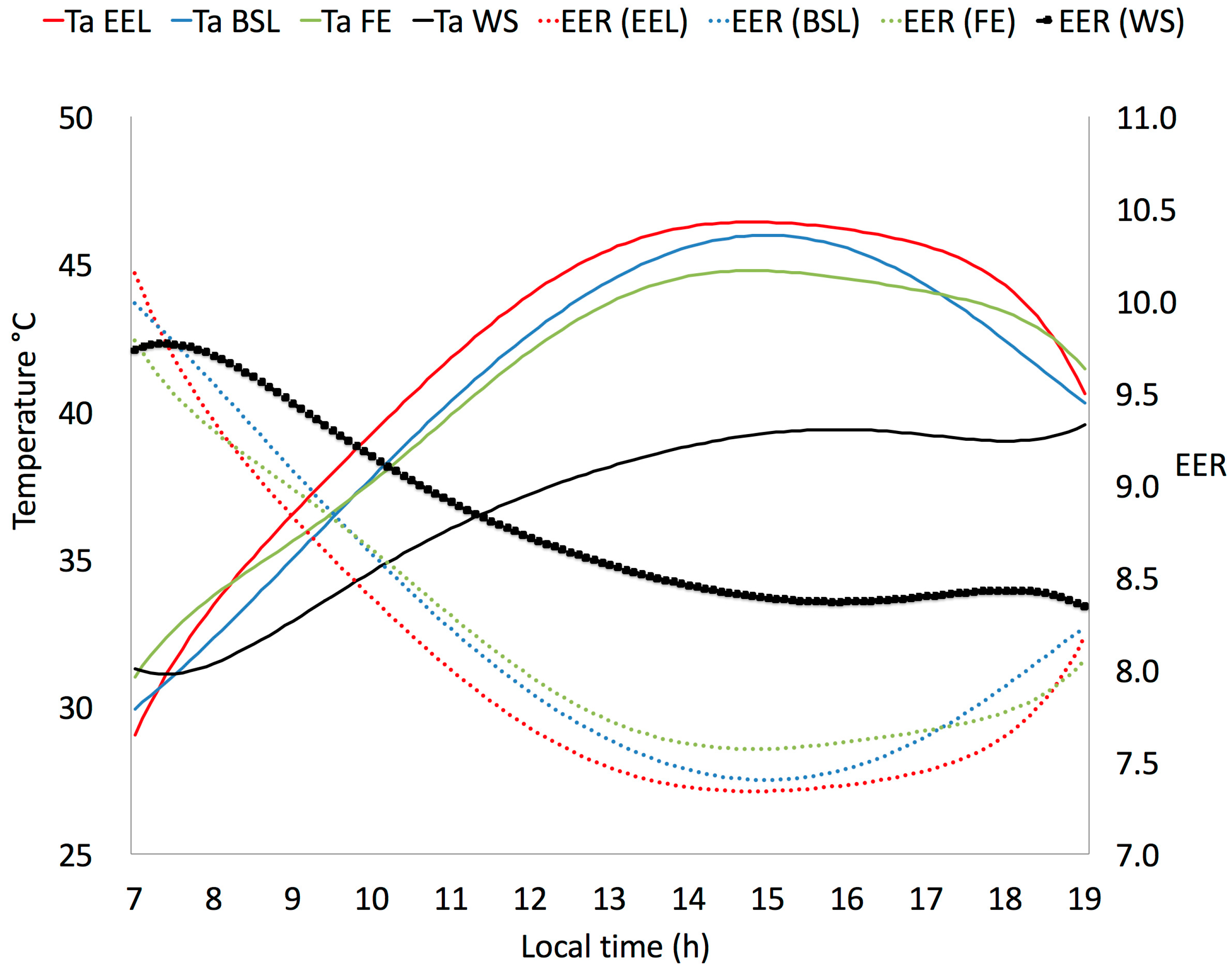
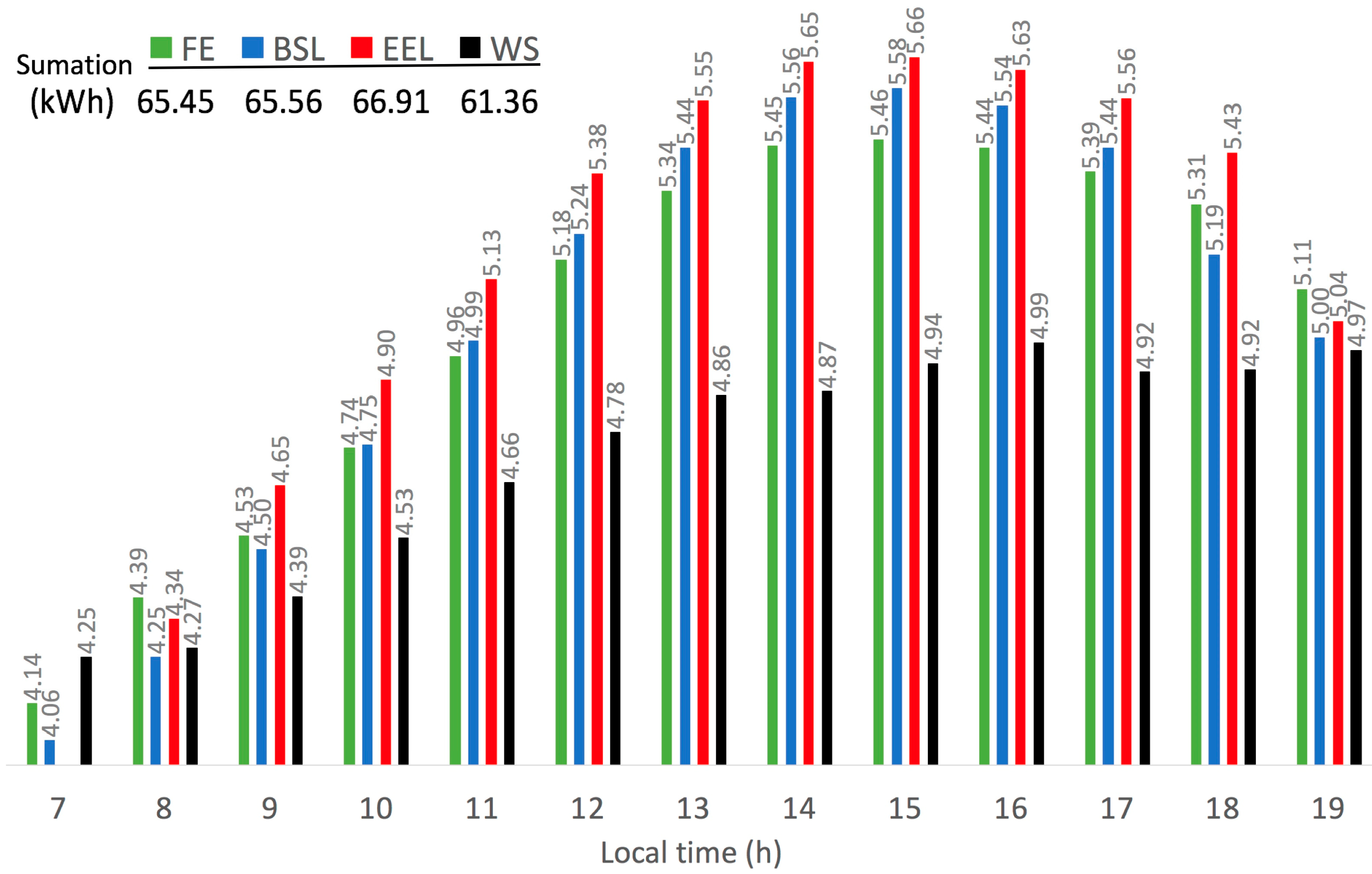
| Building | Roof Materials | |
|---|---|---|
| EEL | Electrical Engineering Laboratory | Galvanized steel sheet painted with gray paint |
| BSL | Basic Sciences Laboratory | Galvanized steel sheet covered with sprayed polyurethane |
| FE. | Faculty of Engineering | Insulated concrete slab with 2″ expanded polystyrene covered with gray roofing felt |
| Instrument | Model | Purpose | Quantity | Range | Error |
|---|---|---|---|---|---|
| Datalogger CR23X | Campbell Scientific | Thermocouple data storage | 3 | N/A | N/A |
| a Thermocouple T | Omega | Surface temperature reading | 9 | −40 °C to 350 °C | +/−0.35 °C |
| b Hobo U12-011 | Onset | Air temperature reading at the condenser inlet | 3 | −20 °C to 70 °C | +/−0.35 °C |
| c Temperature Probe HMP45C (WS.) | Vaisala | Air temperature reading at the weather station | 1 | −40 °C to 60 °C | +/−0.4 °C |
| Pairs of Study Sites Considered * | EEL vs. BSL | BSL vs. FE | EEL vs. FE | EEL vs. WS | BSL vs. WS | FE vs. WS |
|---|---|---|---|---|---|---|
| p-value | 0.008 | 0.004 | 8.22 × 10−8 | 7.35 × 10−25 | 2.09 × 10−20 | 7.63 × 10−16 |
| Site | 07:00 | 08:00 | 09:00 | 10:00 | 11:00 | 12:00 | 13:00 | 14:00 | 15:00 | 16:00 | 17:00 | 18:00 | 19:00 | Avg. | Std. Dev. |
|---|---|---|---|---|---|---|---|---|---|---|---|---|---|---|---|
| Temperature at 0.59 m (Ta) | |||||||||||||||
| EEL | 29.09 | 33.30 | 36.75 | 39.33 | 41.66 | 44.01 | 45.56 | 46.38 | 46.46 | 46.21 | 45.61 | 44.46 | 40.72 | 41.50 | 5.54 |
| BSL | 29.94 | 32.28 | 35.14 | 37.76 | 40.24 | 42.69 | 44.56 | 45.63 | 45.82 | 45.46 | 44.56 | 42.23 | 40.32 | 40.51 | 5.29 |
| FE | 30.98 | 33.87 | 35.47 | 37.69 | 39.90 | 42.11 | 43.63 | 44.60 | 44.74 | 44.56 | 44.05 | 43.35 | 41.45 | 40.49 | 4.60 |
| Surface temperature (Ts) | |||||||||||||||
| EEL | 25.27 | 33.89 | 46.31 | 56.15 | 64.69 | 71.92 | 76.07 | 75.55 | 72.05 | 66.49 | 59.49 | 49.36 | 37.25 | 56.50 | 16.87 |
| BSL | 28.43 | 36.14 | 41.09 | 46.74 | 52.72 | 54.30 | 57.39 | 57.69 | 56.36 | 54.07 | 51.12 | 46.08 | 40.44 | 47.89 | 9.10 |
| FE | 26.66 | 32.61 | 42.56 | 51.05 | 57.98 | 64.38 | 68.66 | 69.51 | 67.46 | 63.87 | 59.10 | 52.81 | 45.23 | 53.99 | 13.86 |
| Weather station (WS) | |||||||||||||||
| WS | 31.28 | 31.52 | 32.92 | 34.49 | 36.00 | 37.36 | 38.35 | 38.45 | 39.23 | 39.78 | 38.99 | 39.05 | 39.58 | 36.69 | 3.12 |
| Δ Kilowatt Hour = Δ Emissions | Greenhouse Gas Emissions Equivalent to |
|---|---|
| 5.55 kWh = 3.9 kg CO2e | 9.8 miles driven by an average passenger vehicle 0.443 gallons of gasoline consumed |
| 4.4 pounds of coal burned | |
| 478 smartphones charged | |
| 0.161 propane cylinders used for home barbeques | |
| 4.2 = 3 kg CO2e | 7.4 miles driven by an average passenger vehicle 0.335 gallons of gasoline consumed 3.3 pounds of coal burned 362 smartphones charged 0.122 propane cylinders used for home barbeques |
| 4.09 = 2.9 kg CO2e Summary: 13.84 = 9.8 kg CO2e | 7.2 miles driven by an average passenger vehicle 0.326 gallons of gasoline consumed 3.2 pounds of coal burned 353 smartphones charged 0.181 propane cylinders used for home barbeques 4.3 miles driven by an average passenger vehicle 1.1 gallons of gasoline consumed 10.9 pounds of coal burned 1193 smartphones charged 0.401 propane cylinders used for home barbeques |
Disclaimer/Publisher’s Note: The statements, opinions and data contained in all publications are solely those of the individual author(s) and contributor(s) and not of MDPI and/or the editor(s). MDPI and/or the editor(s) disclaim responsibility for any injury to people or property resulting from any ideas, methods, instructions or products referred to in the content. |
© 2023 by the authors. Licensee MDPI, Basel, Switzerland. This article is an open access article distributed under the terms and conditions of the Creative Commons Attribution (CC BY) license (https://creativecommons.org/licenses/by/4.0/).
Share and Cite
Santillán-Soto, N.; Lambert-Arista, A.A.; Flores-Jiménez, D.E.; Ojeda-Benítez, S.; Cruz-Sotelo, S.E.; Velázquez-Limón, N.; López-Zavala, R. Air Temperature Variations Due to Different Roofs and Their Impact on Energy Consumption and Emissions: Mexicali University Campus Case Study. Atmosphere 2023, 14, 945. https://doi.org/10.3390/atmos14060945
Santillán-Soto N, Lambert-Arista AA, Flores-Jiménez DE, Ojeda-Benítez S, Cruz-Sotelo SE, Velázquez-Limón N, López-Zavala R. Air Temperature Variations Due to Different Roofs and Their Impact on Energy Consumption and Emissions: Mexicali University Campus Case Study. Atmosphere. 2023; 14(6):945. https://doi.org/10.3390/atmos14060945
Chicago/Turabian StyleSantillán-Soto, Néstor, Alejandro A. Lambert-Arista, David E. Flores-Jiménez, Sara Ojeda-Benítez, Samantha E. Cruz-Sotelo, Nicolás Velázquez-Limón, and Ricardo López-Zavala. 2023. "Air Temperature Variations Due to Different Roofs and Their Impact on Energy Consumption and Emissions: Mexicali University Campus Case Study" Atmosphere 14, no. 6: 945. https://doi.org/10.3390/atmos14060945
APA StyleSantillán-Soto, N., Lambert-Arista, A. A., Flores-Jiménez, D. E., Ojeda-Benítez, S., Cruz-Sotelo, S. E., Velázquez-Limón, N., & López-Zavala, R. (2023). Air Temperature Variations Due to Different Roofs and Their Impact on Energy Consumption and Emissions: Mexicali University Campus Case Study. Atmosphere, 14(6), 945. https://doi.org/10.3390/atmos14060945











